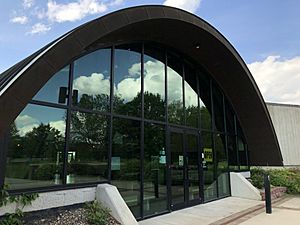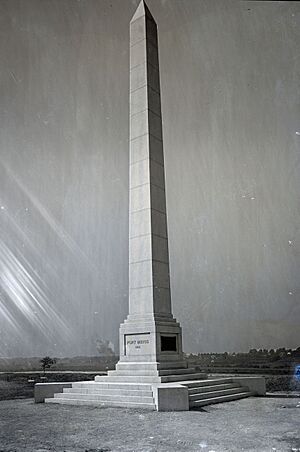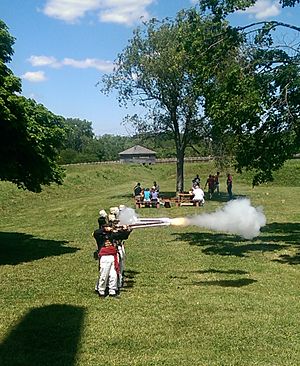Fort Meigs facts for kids
|
Fort Meigs
|
|

Dressed in clothing of the period, these guides at Fort Meigs Historic Site prepare to give a tour of the facility on a clear day in the summer
|
|
| Location | Perrysburg, Ohio |
|---|---|
| Area | 62.25 acres (25.19 ha) |
| Built | 1813 |
| NRHP reference No. | 69000151 |
Quick facts for kids Significant dates |
|
| Added to NRHP | August 4, 1969 |
| Designated NHL | August 4, 1969 |
Fort Meigs was an important United States fort built along the Maumee River in what is now Perrysburg, Ohio. It played a big role during the War of 1812. The British Army, along with their Native American allies led by Chief Tecumseh, tried to capture the fort but failed.
The fort was named after Ohio governor Return J. Meigs Jr.. He helped General William Henry Harrison (who later became president) by providing soldiers and supplies. This support was crucial for the forts protecting the frontier in the Old Northwest region.
Contents
Building Fort Meigs: A Look Back at 1813
Why Fort Meigs Was Built
Construction of Fort Meigs began in February 1813. Soldiers under General William Henry Harrison started building it in the area where Perrysburg, Ohio is today. The fort was meant to be a place to store supplies and prepare for U.S. military actions in Canada. It also controlled an important part of the Maumee River. Across the river, downstream, were the old remains of the British Fort Miami.
Life and Challenges During Construction
The winter weather was very harsh. The land was difficult to work with. The fort's walls were made from logs, 15 feet long, partly buried in the ground. A steep dirt slope was piled against the logs to make them stronger against cannon fire. Inside, a dirt wall provided protection for the soldiers. When finished, Fort Meigs was the largest wooden-walled fort in North America.
Battles at Fort Meigs: The War of 1812
The First Siege: May 1813
On May 1, 1813, British forces led by General Henry Proctor and Native American allies led by Chief Tecumseh began attacking the fort. They fired cannons at Fort Meigs, which had about 1,200 American soldiers. This was called a siege, where an army tries to capture a fort by surrounding it and attacking.
More American soldiers arrived on May 4, bringing the total to 2,800. Early on May 5, a group of American soldiers landed on the north side of the river. They attacked the British cannons there and made them unusable. However, Native American warriors in the woods attacked the American soldiers. The Americans, who were not organized, chased the warriors deeper into the forest.
Dudley's Defeat
In the woods, the American soldiers suffered heavy losses. Many were captured. Out of 866 American officers and men, only 150 returned to the fort. This event became known as "Dudley's Defeat."
Native American warriors also attacked any groups leaving the fort to gather wood. General Harrison protected his soldiers inside the fort by building two tall dirt walls, called "traverses," inside the fort. These walls helped absorb the British cannonballs. General Proctor gave up the siege on May 9, 1813, and went back to Detroit.
The Second Siege: July 1813
After the first siege, General Harrison left General Green Clay in charge of Fort Meigs. The fort was made smaller than its original size. In July 1813, the British tried again to capture Fort Meigs to please their Native American allies. The Native Americans pretended to have a battle to trick the American soldiers into leaving the fort. However, the Americans realized it was a trick and stayed inside.
After this failed attempt, the British moved on to attack Fort Stephenson, where Fremont, Ohio is today. That attack also failed, and the British had to retreat to Canada.
Fort Meigs After the War
Once the British left the area for good, General Harrison ordered Fort Meigs to be taken apart. A smaller fort was built in its place to store supplies and protect the river. The Treaty of Fort Meigs was signed there in 1817, and the fort was completely abandoned that same year.
Remembering Fort Meigs: A Historic Site
Preserving the Past
In 1864, brothers Timothy and Thomas Hayes bought the land where the fort once stood. They worked hard to preserve the memory of the soldiers who fought there. Their family later sold the property to the state in 1907. On September 1, 1908, a large monument, which you can still see today, was dedicated to the fallen soldiers of Fort Meigs.
The Ohio Historical Society rebuilt the fort in the late 1960s. Its museum, which shows many items found during the rebuilding, opened in 1974. Today, Fort Meigs is recognized as a National Historic Landmark.
Fort Meigs Today: A Park and Museum
As of 2025, Fort Meigs is an Ohio State Memorial in Perrysburg. The park covers 65 acres and includes a full-size, 10-acre copy of the 1813 fort. Between 2000 and 2003, the wooden walls were rebuilt with new timber. The seven blockhouses (small forts) were repaired, and exhibits were added inside four of them.
A $6.2 million project also replaced the old museum with a new Museum and Education Center. This center is 14,000 square feet and has 3,000 square feet of exhibits. These exhibits focus on Ohio's role in the War of 1812. The center also has classrooms for students and adults. The museum exhibit, "Legacy of Freedom: Fort Meigs and the War of 1812," helps visitors understand the time period, the conflict, and why it's important to remember.
The original grand dirt wall (traverse) is still inside the fort, though it's not as tall as it used to be. A new reverse traverse was built to look like the original. You can also find the remains of a British cannon position in a nearby cemetery.
Experience History: Re-enactments at Fort Meigs
Fort Meigs hosts several exciting re-enactment events each year:
- First Siege: This battle re-enactment shows what happened during the siege of Fort Meigs in May 1813. You can see American and British soldiers and cannons. This event happens on Memorial Day weekend. A ceremony for fallen soldiers follows on Monday.
- Muster on the Maumee: This event, held on Father's Day weekend, features military re-enactors from many different time periods. You might see everything from ancient Roman soldiers to modern-day soldiers.
- Independence Day: This re-enactment shows how the Fourth of July was celebrated in 1813. It includes toasts and an 18-gun salute.
- Garrison Ghost Walk: Held on the last two weekends in October, a re-enactor guides visitors through the dark fort. They tell spooky ghost stories about the fort's past.






